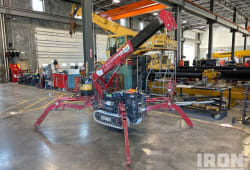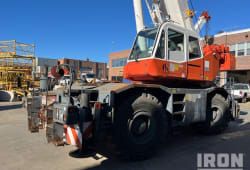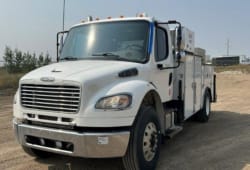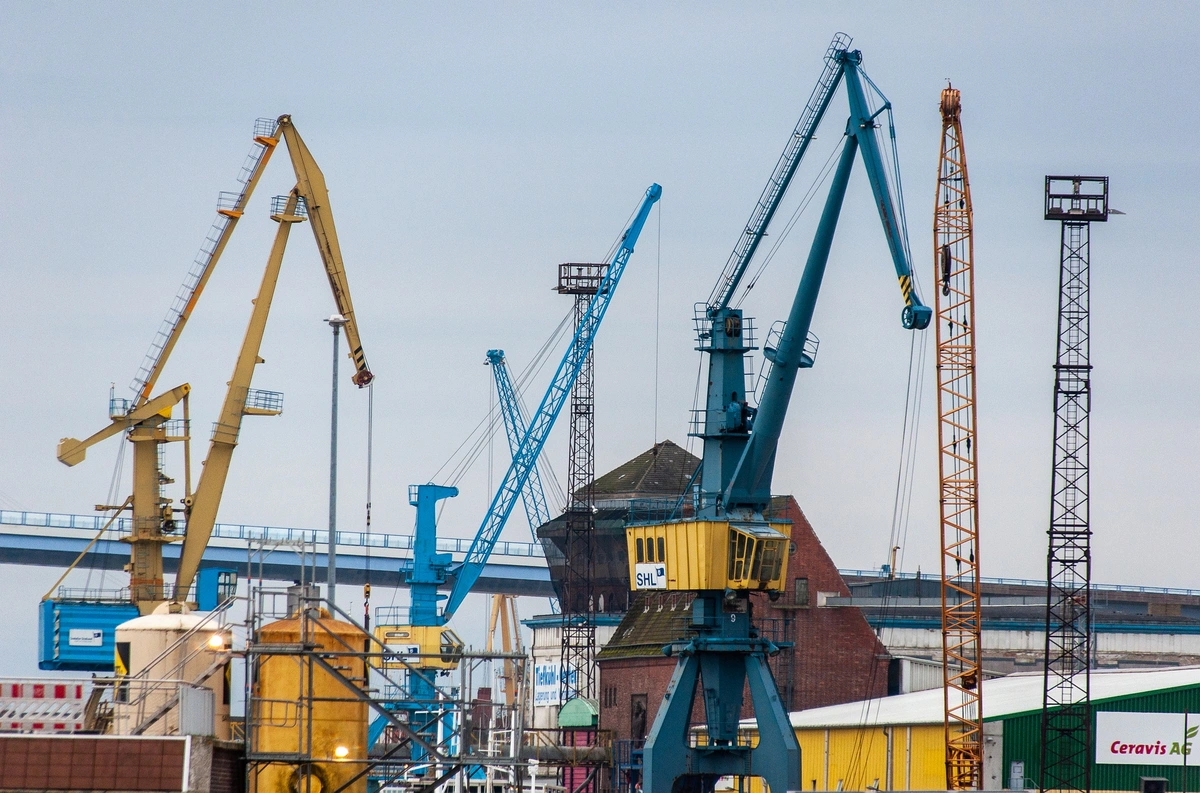101- All You Need to Know About Cranes
9 Min read
)
September 9, 2023
Cranes are remarkable machines that have played a crucial role in various industries, from construction to manufacturing and beyond. In this comprehensive guide to true cranes, we'll dive into the fascinating world of cranes, exploring their types, applications, components, safety measures, lifting capabilities, power lines, maintenance procedures, technological advancements, operator training, environmental impact, and iconic projects that showcase their versatility.
Types of Cranes and Their Applications
Think about cranes as different kinds of big machines that are used to lift and move heavy objects. Just like there are different tools for different jobs, there are various types of cranes, each made for a specific purpose.
For example, there are deck cranes that are tower cranes that are tall and stand still in one place. You might see these cranes on big construction projects, helping to build skyscrapers and other tall buildings. They're the cranes who live like the giants of the crane world, working high up in the sky.
Then there are mobile cranes, which are like huge trucks with long arms that can move around. These cranes are useful when the job requires going to different locations. They can carry heavy things and take them wherever they're needed, kind of like a super-strong delivery truck.
Crawler cranes are another type, known for their strong stability. They have special tracks like a tank, which helps them stay balanced while lifting heavy loads. These cranes are often used in projects where it's important to keep things steady and avoid any wobbling.
Crane Components and Terminology Explained
Think of a crane as a big, powerful machine that helps lift and move heavy things. Now, just like a puzzle, a crane is made up of many different pieces, and each piece has a special name. Understanding what these pieces are called and what they do is important to use the right crane part safely and make sure it works smoothly.
Let's go through some of these important parts:
1. Boom: The boom truck-mounted crane is like a long arm that reaches out from the crane. It's what gives the crane its height and allows it to reach far distances.
2. Jib: The jib is like another arm attached to the boom Sarus crane. It can be adjusted to different angles and lengths to help position the things the crane is lifting.
3. Hoist: The hoist is like the crane's strong muscles. It's what does the actual lifting of heavy objects. The hoist pulls things up and lowers them down safely.
4. Hook: The hook is like the hand of the crane. It grabs onto the things we want to lift and holds them securely.
Now, why is all this important? Well, think of it like driving a car. If you don't know what the gas pedal or the brakes do, you might have trouble driving safely. Similarly, if you don't understand how the boom, jib, hoist, and hook work, it could be dangerous to operate the crane.
Safety Guidelines for Operating Cranes
Consider the careful approach you take when handling something valuable, like delicate artwork. Just as you follow specific steps to ensure its protection, when it comes to operating cranes on construction projects, there are critical safety measures in place. This section serves as a comprehensive guidebook, illuminating the precise actions crane operators must take to guarantee the security and well-being of all individuals on-site.
Visualize this as a detailed roadmap, akin to a treasure map leading to safety. Every step outlined in this guide is akin to a marker on this map, each contributing to the overall goal of incident-free crane operation. Similar to a conductor ensuring a flawless symphony, adhering to these safety guidelines orchestrates a harmonious work environment where accidents are thwarted, and the health of everyone involved in crane dance is safeguarded.
Crane Lifting Capacities and Load Charts
Think of a crane as a giant mechanical arm that is used to lift heavy things, like construction materials or equipment. When using a crane, it's important to know how much weight it can safely lift without causing any problems.
If you have a big chart that tells you the maximum weight the crane can lift based on different conditions. This chart takes into account a few important factors:
1. Radius: This is the distance from the centre of the crane to the point where it's picking up the load. The farther the load is from the crane, the less weight it can safely lift.
2. Boom Length: The boom is the long arm of the crane that extends and helps lift things. The length of the boom affects how much weight the crane can handle. A longer boom might be able to lift heavier loads with less weight compared to a shorter boom.
3. Load Type: Different types of loads (like a heavy beam or a large container) put different amounts of stress on the tower crane. Some loads are trickier to lift than others, so the crane's chart takes a few species into account.
So, when you're using a crane, you need to look at this chart to figure out how much weight it can lift based on the crane species-specific conditions - like how far the load is from the crane and how long its boom is.
Must Read: How Are Cranes Transported? Things to Know
Crane Maintenance and Inspection Procedures
Just like how you need to take care of your car or your bicycle to keep them working well, cranes also need regular care to stay in good shape and work safely. This process is called "maintenance."
Maintenance means doing things to make sure the crane stays in the best possible condition and doesn't break down unexpectedly. You have a checklist of tasks you need to do to keep the crane running smoothly.
Inspection is like giving the crane a thorough check-up. It's similar to going to the doctor for a check-up to make sure you're healthy. Inspecting a crane means looking at all its parts and making sure everything is working as it should.
Here's what this part of the content means:
1. Maintenance Schedules
This is like having a plan for when and what kind of maintenance tasks need to be done. Just like you might have a schedule for changing the oil in your car, a crane also has a schedule for tasks like oiling its moving parts, tightening bolts, and other things that keep it working well.
2. Routine Checks
These are quick looks to make sure everything is okay. Like how you might quickly check your bicycle's tyres before you ride it, a crane also gets routine checks to catch any small issues before they become big problems.
3. Troubleshooting Common Issues
Sometimes, things might go wrong even if you take good care of the crane. Troubleshooting means figuring out what's causing the problem and finding a way to fix it. It's like when your computer isn't working right, and you try to figure out why and make it work again.
So, "crane maintenance and inspection procedures" are all about taking care of the crane by doing regular tasks to prevent problems, checking it thoroughly to catch any issues, and knowing what to do if something goes wrong. It's a bit like looking after a big, heavy-duty machine to keep it safe and working properly.
Advancements in Crane Technology and Automation
Crane technology is rapidly advancing, bringing in new automated features that are similar to how your smartphone operates tasks without manual input. These innovations are like upgrades for cranes, enhancing their performance and efficiency.
1. Remote Control Operation: Just as you can control your TV with a remote, cranes can now be operated from a distance. This means a person can control the crane's movements and functions from a safe location near the construction job site, without needing to be physically next to the crane.
2. Anti-Collision Systems: Similar to how cars have sensors to prevent accidents, cranes are adopting comparable technology. These systems use sensors to ensure that two cranes, or a crane and another object, avoid accidental collisions. It's like having an extra set of eyes to maintain crane safety.
3. Real-Time Monitoring: This is akin to having a live video feed of the crane's actions. It allows individuals to see exactly what the crane operator sees, even from a remote location. This close monitoring helps ensure the mobile crane always operates smoothly and without issues.
Crane Operator Training and Certification
Becoming a crane operator requires specialized training and certification. We'll walk you through the training process, necessary qualifications, and the importance of skilled operators in our construction companies in ensuring safe and efficient construction crane operations.
The construction site used a variety of cranes, including carry deck cranes, crawler cranes, rough terrain cranes, and hammerhead cranes. The demoiselle crane, a small, slender crane, was also spotted in the area.
Environmental Impact and Sustainable Practices in Crane Operations
Cranes play a role in shaping the environment and contributing to sustainability efforts. Discover how environmentally friendly practices of multiple cranes, such as energy-efficient designs and reduced emissions, are making cranes more eco-friendly.
Conclusion
In this comprehensive guide, we've covered everything you need to know about cranes. From their symbolic significance to their technical aspects, applications, safety measures, and environmental impact, cranes are an integral part of modern industry and innovation. Whether you're a curious reader or a professional seeking to expand your knowledge, this guide offers valuable insights into the world of cranes.
Visit Boom & Bucket to buy and sell your machinery.














